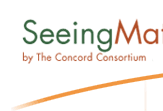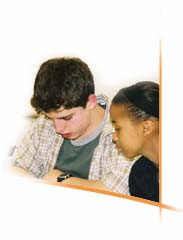         |

Evaluation Methods Behind Seeing Math™
 In
late 2000, the U.S. Department of Education awarded a grant to The
Concord Consortium to study the use of the Internet to deliver professional
development resources to elementary and middle school math teachers.
The grant launched a rigorous research and development project
that culminated in the creation of Seeing Math™ Elementary. In
late 2000, the U.S. Department of Education awarded a grant to The
Concord Consortium to study the use of the Internet to deliver professional
development resources to elementary and middle school math teachers.
The grant launched a rigorous research and development project
that culminated in the creation of Seeing Math™ Elementary.
Over the past several years, The Concord Consortium has used
scientifically based evaluation methods to assess whether the project produces meaningful effects on student achievement or teacher performance. Together with the independent
evaluation firm Edcentric, we have collected and analyzed data from pilot
school implementations of Seeing Math™ Elementary (SME) across the country to:
- Evaluate
the quality and usefulness of project materials and strategies.
- Research
the effect and impact of the Seeing Math™ materials.
The research
analyzed:
- Quantitative
data, such as pre- and post-course test scores of participating
teachers as well as student performance on standardized tests.
- Qualitative
data gathered from surveys and interviews.
Findings from pilot schools during the 2003-2004 school
year indicated that Seeing Math™ Elementary had a significant impact
on both content and pedagogy gains for participating teachers and
improvements in student achievement:
- 85% of participating
teachers stated that Seeing Math™ Elementary influenced how they
teach.
- Test scores
demonstrated improvements in teacher content mastery.
- Data indicated
an overall increase in student performance on standardized tests.
In late 2003,
when initial findings demonstrated the benefit and effectiveness
of the program's content and approach, The Concord Consortium was
awarded additional funds to pursue the research and development
of a similar professional development program — Seeing Math™ Secondary (SMS) — aimed
at secondary school algebra teachers.
Research related to Seeing Math™ Secondary began in the spring of 2004.
Early qualitative research by
Edcentric into the perceived value of videos, interactive software,
online discussions, and general content showed that a majority of pilot
participants found all of these to be extremely valuable.
Final reports for both Seeing Math™ Elementary and Seeing Math™ Secondary demonstrate
the continuing and increasing positive impact of project materials on
the success of teachers and their students.
- Significant differences between gains for treatment and control teachers offer evidence that participation in SME can provide teachers with relevant new learnings in a number of different content and pedagogic areas (Edcentric, 2005, p. iv).
- As a result of taking the SMS course modules, a mathematically well-prepared sample of teachers was found to learn primarily in pedagogy as opposed to specific content areas (Edcentric and Hezel Associates, 2005, p. v).
The extensive research, refinement and testing of the Seeing Math™
projects provides teachers, schools and districts assurance that the
program is built on a solid foundation of effective content and proven
instructional strategies. |

 |



 In
late 2000, the U.S. Department of Education awarded a grant to The
Concord Consortium to study the use of the Internet to deliver professional
development resources to elementary and middle school math teachers.
The grant launched a rigorous research and development project
that culminated in the creation of Seeing Math™ Elementary.
In
late 2000, the U.S. Department of Education awarded a grant to The
Concord Consortium to study the use of the Internet to deliver professional
development resources to elementary and middle school math teachers.
The grant launched a rigorous research and development project
that culminated in the creation of Seeing Math™ Elementary.